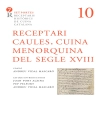Calories—too few or too many—are the source of health problems affecting billions of people in today’s globalized world. Although calories are essential to human health and survival, they cannot be seen, smelled, or tasted. They are also hard to understand. In
Why Calories Count, Marion Nestle and Malden Nesheim explain in clear and accessible language what calories are and how they work, both biologically and politically. As they take readers through the issues that are fundamental to our understanding of diet and food, weight gain, loss, and obesity, Nestle and Nesheim sort through a great deal of the misinformation put forth by food manufacturers and diet program promoters. They elucidate the political stakes and show how federal and corporate policies have come together to create an ‘eat more’ environment. Finally, having armed readers with the necessary information to interpret food labels, evaluate diet claims, and understand evidence as presented in popular media, the authors offer some candid advice: Get organized. Eat less. Eat better. Move more. Get political.
Table des matières
Introduction
Part One. Understanding Calories: It All Starts with the Science
1. What Is a Calorie?
2. The History: From Ancient Greece to Modern Calorie Science
3. Foods: How Scientists Count the Calories
4. Bodies: How Scientists Measure the Use of Calories
Part Two. Why You Need Calories: Survival, Warmth, and Work
5. Metabolism: How the Body Turns Food into Energy
6. The First Use of Calories: Basic Life Functions
7. The Second Use: Heat Losses while Metabolizing Food
8. The Third Use: Physical Activity
Part Three. Calorie Intake and Its Regulation
9. How Many Calories Do You Need?
10. Calorie Confusion: The Struggle to Estimate Intake
11. Secret Calories: Alcohol
12. Calorie Regulation: The Body’s Complex Weight Management System
Part Four. Too Few Calories
13. Starvation and Its Effects on the Body
14. Individuals, Communities, Nations: Calories and Global Hunger
15. Could Restricting Calories Prolong Human Life?
Part Five. Too Many Calories
16. An Introduction to Obesity
17. Calories and Weight Gain: Another Complex Relationship
18. Do Excess Calories Make Some People Gain Weight Faster than Others?
19. Are All Calories Created Equal?
20. Do Some Kinds of Diets Work Better than Others?
Part Six. The Politics of Calories: A Closer Look
21. Today’s “Eat More” Environment: The Role of the Food Industry
22. More Calorie Confusion: Portion Distortion, Health Halos, and Wishful Thinking
23. Calorie Labeling: Science and Politics
24. Alcohol Labels: Industry vs. Consumers
25. Will Calorie Labels Help Fight Obesity?
Conclusion: How to Cope with the Calorie Environment
Appendix One. Selected Events in the History of Calories, 1614 – 1919
Appendix Two. The Respiratory Quotient (RQ)
Appendix Three. Frequently Asked Questions
Notes
List of Tables
List of Figures
Acknowledgments
Index
A propos de l’auteur
Marion Nestle is Paulette Goddard Professor in the Department of Nutrition, Food Studies, and Public Health and Professor of Sociology at New York University. She is the author of What to Eat and, from UC Press, Food Politics: How the Food Industry Influences Nutrition and Health; Safe Food: The Politics of Food Safety; and Pet Food Politics: The Chihuahua in the Coal Mine. Malden Nesheim is Professor Emeritus of Nutritional Sciences at Cornell University. He is coauthor (with Marion Nestle) of Feed Your Pet Right: The Authoritative Guide to Feeding Your Dog and Cat and (with Ann L. Yaktine) of the Institute of Medicine report Seafood Choices: Balancing Benefits and Risks.












